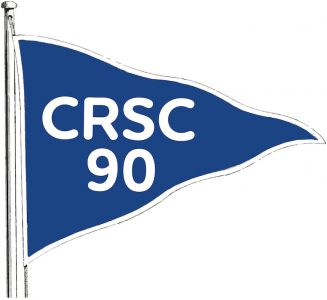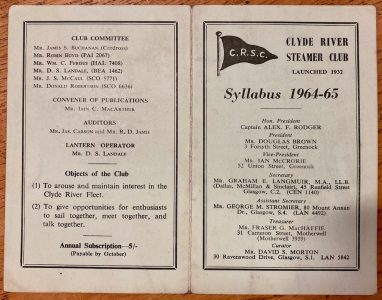MacArthur, McCrorie and MacHaffie: starting with their inexpensive, easy-to-read 1964 booklet Steamers of the Clyde and Western Isles, the ‘Messrs Mac’ inspired a transformation of the Clyde River Steamer Club. A group accustomed to chatting about the past became an organisation intent on doing something tangible, widening its activities to include big ship charters, printed publications and coordinated research
The 1960s saw a transformation in the fortunes of the Clyde River Steamer Club. Previously a cosy group of nostalgia-filled enthusiasts, it became a dynamic organisation with a youthful edge — keen to illuminate the past, document the present and take an active interest in the future.
This is the latest in a series of articles tracing the development of CRSC since it was founded in 1932.
On the surface, the outlook for steam aficionados in the early 1960s was not good: the railways were moving rapidly to ‘dieselisation’, and the number of steam-powered vessels emerging from Clyde shipyards was rapidly dwindling (Queen Elizabeth 2 in 1967 being one of the last). The vitality and financial wellbeing of the Caledonian Steam Packet Company was in free-fall, evidenced by the withdrawal after the 1964 summer of two great favourites, Duchess of Montrose and Jeanie Deans, and the ‘wee ferries’ Ashton and Leven.
Paradoxically, these developments coincided with the emergence of a group of young enthusiasts who would imbue CRSC with new life, swelling its numbers and modernising its personality.
Most of them had come of age in the 1950s: they were as familiar with diesel propulsion as they were with steam. Many were beneficiaries of the postwar boom in higher education; some had spent student summers as assistant pursers on the steamers. They brought ambition, energy and ideas to CRSC’s activities.
●
The first half of the decade followed the pattern of the late 1950s: winter meetings at the Central Halls in Bath Street, annual circulation of an A4 typed and duplicated Review, charters of Countess of Breadalbane.
Willie Fergus — friend of CRSC founders George Stromier and Leo Vogt and, like them, member of an informal sub-group of older enthusiasts called ‘The Eccentrics’ — was president in 1960-61 and chose ‘Random Recollections of Sailing on the Clyde’ as the title of his presidential address. Speakers over the course of that winter included the likes of Alex Murdoch, Donald Robertson, Dick Smith — all Club stalwarts.
 The chartering of the ‘Breadalbane’ — to Rothesay and Loch Striven in 1960, Millport in 1961, downriver from Bridge Wharf to Greenock Custom House Quay and Helensburgh to view the Comet replica in 1962, Carrick Castle in 1963, Ormidale in 1964 — set a pattern for special sailings, albeit on a small scale.
The chartering of the ‘Breadalbane’ — to Rothesay and Loch Striven in 1960, Millport in 1961, downriver from Bridge Wharf to Greenock Custom House Quay and Helensburgh to view the Comet replica in 1962, Carrick Castle in 1963, Ormidale in 1964 — set a pattern for special sailings, albeit on a small scale.
The 1962 Comet celebrations (marking the 150th anniversary of the first steamship to operate commercially in open waters) included a special ‘Clyde Steamers and Shipping’ exhibition at the Watt Museum in Greenock. This initiative was undertaken by Douglas Brown, scion of a distinguished Greenock shipbuilding family, who went on to become Club president in 1964-65.
In December 1962 the Club celebrated its own 30th anniversary with a dinner at the Ca’doro restaurant.
But 1962 had a wider significance: it was the year in which the Club began to take notice of three younger enthusiasts who were breathing fresh wind into its proceedings. On 14 March, a 20-year old Greenockian named Ian McCrorie contributed to a presentation titled ‘Four Clyde Ships to Remember’. At the AGM the following month, he and Fraser MacHaffie were elected to the committee, the latter as Treasurer. They were soon joined by Iain MacArthur (assistant purser of Duchess of Montrose 1956-58), for whom a new post, Convener of Publications, was created in 1964. That year the three produced Steamers of the Clyde and Western Isles, a handy booklet giving information about and photographs of each vessel in the west coast fleet. Published just in time for the summer season, it was sold on CSP and MacBrayne steamers, and included an advert for CRSC.
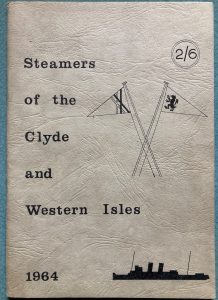
Front cover of the 1964 edition of Steamers of the Clyde and Western Isles. Techniques learnt in its production were used for the development of CRSC publications
The booklet was a huge success, triggering a rise in CRSC membership numbers. It became the springboard not only for a second edition in 1965 and a sister booklet, Clyde Steamers of Yesteryear, but also for the threesome’s growing influence on the workings and personality of the Club, and its appeal to young enthusiasts.
Ian McCrorie and Fraser MacHaffie had met as students at Glasgow University, and graduated on the same day in July 1963. Fraser recalls how Ian first came to his notice in late September 1959 — at Wemyss Bay, when Ian was assistant purser on Cowal. “I can’t remember what I was doing there. At that time, after the September Weekend, an ABC ferry would go down to Fairlie to give Glen Sannox a few days off in dry dock. I had seen Cowal sailing past Largs en route to Fairlie. Ian and I started studying at university that October. The ‘Mathematics I’ class was broken into sections alphabetically, and all the Mcs and Macs were in the same class. Ian was seated right in front of me. At the end of the class I introduced myself and mentioned I had seen Cowal moving down to Fairlie. We would often meet for lunch. I mentioned the Steamer Club to him — and the rest is history.”
Fraser’s recollection of meeting Iain MacArthur is more vague, but their first encounter seems to have been in September 1960 on Caledonia (of which Fraser was assistant purser), when she was finishing the Bridge Wharf season in place of Queen Mary II. He remembers that “a second assistant purser had been appointed to Caledonia. The second assistant was a rather obnoxious individual but a contemporary of Iain. Iain must have been visiting him.”
The three Macs discovered a shared interest in documenting Clyde and west highland services. Iain MacArthur had kept diaries of MacBrayne movements since the mid 1950s. Separately, Ian McCrorie was drawing up ‘news notes’, including a diary of ships visiting the Albert and East India Harbours, which Fraser typed up at home in Motherwell and duplicated on a Gestetner machine, amounting to a dozen foolscap sheets. The first month was October 1961 and distribution was confined mainly to fellow assistant pursers. Iain MacArthur subsequently took over the news gathering. The interest generated by these ‘diaries’ among enthusiast friends pointed to the possibility of a more sophisticated annual Review than the Club was producing.
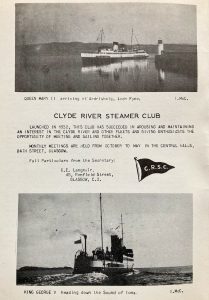
The Messrs Mac ensured that their fledgling publication included an advert for CRSC. Click on image to enlarge
Iain says that “the three of us planned our strategy: we were going to do a lot of research. I remember going with Fraser one evening to the Glasgow Herald offices, where George Stromier worked. They were getting rid of a set of back copies and we were allowed to take what we wanted, lugging them back home by train. We were mad about steamers, what they did, what routes they were on — it was an obsession. Fraser had a sharp accountant’s mind — serious, accurate, precise. You relied on him to get things done. Ian was ebullient, full of enthusiasm. He got us access to Gourock — he could charm the birds off the trees [proof of which was the hugely successful series of big ship charters he organised as CRSC convener of cruises 1966-76]. He achieved what no one else would have done.”
But Fraser reckons it was Iain MacArthur who spearheaded the two printed publications that were to establish CRSC’s reputation in the wider maritime world — Clyde Steamers and the annual Review. “The problem was to produce a magazine that was technically and aesthetically appealing,” he recalls. “At that time the major challenge was making photographic plates: the process was expensive and slow, and we had to watch our costs. My father (chief accountant for Phillips Electrical’s operations in Scotland) had a connection with a printing company which was perfecting a process of etching photographs onto very thin steel plates at a fraction of the cost of the usual steel blocks. He took a photograph of Maid of Skelmorlie and asked the firm to prepare a plate and run off a copy or two. I couldn’t believe the quality. So, we decided to put our personal limited resources into a booklet on the Clyde and Western Isles fleets.
“I think Steamers of the Clyde and Western Isles was one of the very first publications to use the [offset litho] process. At that stage there was a bit of variability in the light/dark aspect in the print and you can see this. Robin Boyd helped with layout and headings, and he designed the cover. I typed the text several times while the text and illustrations were being laid out. All this was done under Iain MacArthur’s supervision. He wrote about three-quarters of the text, with Ian McCrorie doing the balance.
“It was a successful product and most of the assistant pursers sold copies on their ships in the summer of 1964. The CSP and MacBrayne agreed to this, and it is one of the few occasions when I saw some enthusiasm coming out of the Gourock offices!
“We had a process and a team to give us a reasonably good product. On the strength of that, we went to the CRSC committee with a proposal for Clyde Steamers and a printed Review with illustrations. I think the membership had increased over the summer as a result of the booklet — or at least I like to think so.”
The first edition of Clyde Steamers appeared in 1965, and Review 1965 the following year — since when the Clyde River Steamer Club has never looked back.
Compiled by Andrew Clark, with help from Iain MacArthur, Fraser MacHaffie, John Newth and Fiona Stromier.
●
SEE ALSO:
CRSC in the late 60s: an explosion of memorable activity
Stromier & Vogt, Co-Creators of a Club Culture (members only)
CRSC Reviews 1960-64 (paid-up CRSC members only)
CRSC Reviews 1965-69 (paid-up CRSC members only)
●
CRSC is an association of friendly enthusiasts united by the quest to ‘meet together, sail together and talk together’, mainly on the west of Scotland — but many members hail from further afield. If you join us, you’ll receive copies of our much-prized west coast shipping Review and annual magazine, as well as access to a huge library of archive photos in the ‘Members Only’ section of this website. We gather for meetings and cruises throughout the year. To join us, click here.
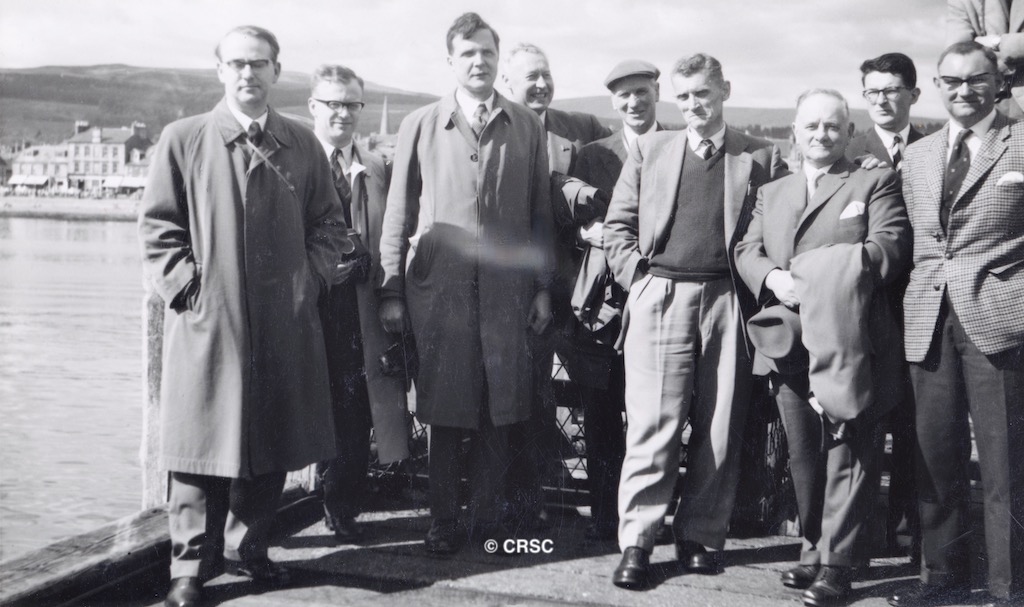
Helensburgh pier on 26 May 1962, during CRSC’s Comet 150th anniversary cruise: (left to right) Alasdair Fraser, George Train, Graham Langmuir, Donald Robertson, Captain Alex Rodger, Leo Vogt, David Morton, Fraser MacHaffie, Robin Boyd
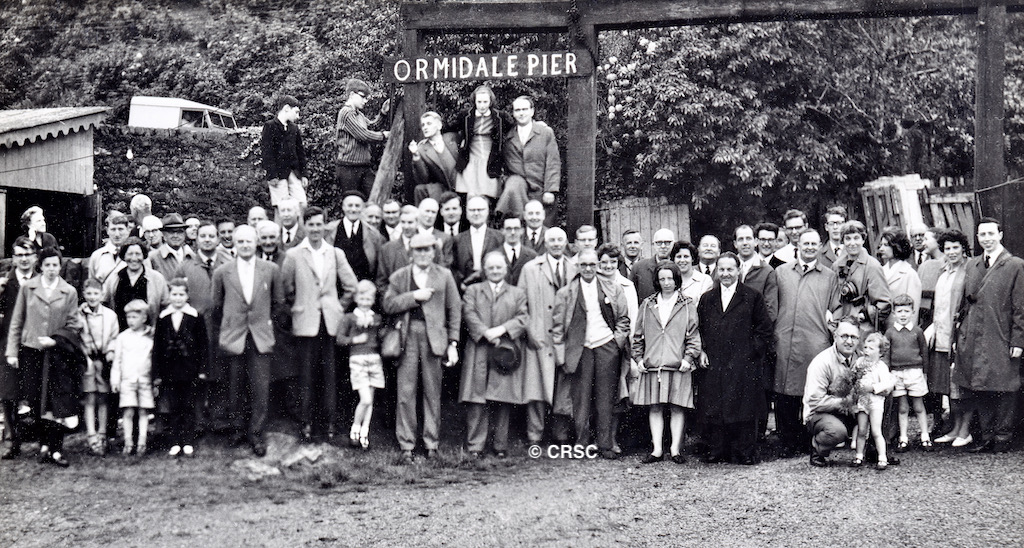
CRSC at Ormidale on 30 May 1964: group photo taken from the deck of Countess of Breadalbane alongside the pier. Ian McCrorie (in tie and dark jacket) stands dead centre at the back between Captain Alex Rodger (honorary president) and George Stromier (founder member). Iain MacArthur (in spectacles) stands immediately to the right of George Stromier, and Fraser MacHaffie, smiling (with spectacles), is on the right half of the picture. Other kenspeckle figures are Neil McArthur, Alex Murdoch, Donald Robertson, Douglas Brown, Robin Boyd, Leo Vogt, David Morton, Alasdair Fraser, Geoffrey Grimshaw, Willie Fergus, Jimmy Miskell and Dick Smith

The ‘Messrs Mac’ outside Jurys Inn, Glasgow, in October 2013, on the occasion of a CRSC talk by Fraser MacHaffie (right) on ‘Aspects of Blockade Running’. Fraser has lived in the US since 1976, but continues to contribute to Clyde Steamers. Iain MacArthur (left) was convener of publications until 1980, and still lives in Greenock. Ian McCrorie (centre) served twice as CRSC president, was convener of cruises 1966-76 and died in 2019. This is the only known photo of the ‘Messrs Mac’ together. Their names will forever be associated with a golden era of CRSC history
Published on 28 September 2023












